Chapter 3: Fostering an Inclusive Economy
Chapter 3: Contents
- Employment sites
- Growth of Oxford’s universities
- University student number thresholds
- University of Oxford
- Oxford Brookes University
- Ensuring Oxford is a vibrant and enjoyable city to live in and visit
- Sustainable tourism
Employment sites
3.1. Oxford is a highly constrained city and the competing demands on the limited land supply are strong, particularly for housing but also for employment floorspace. Policy E1: Employment sites, sets out the approach to establish a balance whereby the employment sites that are well performing and positively contribute to the city’s economy will be given protection from the loss of floorspace, without overly compromising the capacity for the delivery of much needed housing. There is some flexibility within the policy to allow for potential changes in circumstance, and to ensure the strongest employment base possible, which will sometimes rely on the ability to develop supporting uses. Existing employment sites which are not performing well, or which make inefficient use of land will be encouraged to modernise, to better utilise the space. In some limited circumstances, such sites which will also be considered for alternative uses.
3.2. As such, Policy E1 sets out a hierarchical approach to employment categories, stating how existing employment sites will be supported to ensure appropriate levels of protection and intensification. The sites range from Category 1 and 2 sites, which are afforded most protection, to Category 3 and B8 uses which have more flexibility and potential to be released from employment uses for other purposes to ensure the best use of land.
Permissions involving net loss of Category 1 and 2 employment floorspace
3.3. Two permissions have been granted within the monitoring period resulting in the loss of category 2 employment floorspace (Table 2).
| Application reference | Site location | Development summary | Net loss of office/other employment floorspace (sqm) | Summary of alternative use |
|---|---|---|---|---|
| 23/00757/FUL | First Floor, 27 - 28 St Clement's Street, Oxford, OX4 1AB | Change of use of first and second floors from offices (Use Class E) to a House in Multiple Occupation (Use Class C4). Demolition of existing rear shed. Provision of amenity space, bin and cycle stores. | -170 | C4 Residential |
| 23/00769/FUL | 24 Unit D, Peterley Road, Oxford, OX4 2TZ | Change of use from industrial (Use Class B2) to a tyre, exhaust fitting and MOT testing centre (Sui Generis) (Retrospective) | -992 | Sui Generis |
Permissions involving net loss of Category 3 and other employment floorspace
3.4. The 11 permissions that involve the loss or change of use of 2,212.95m2 of Category 3 and other employment floorspace are shown in Table 3 below.
|
Application reference |
Site location |
Development summary |
Net loss of office/other employment floorspace (sqm) |
Summary of alternative use |
|---|---|---|---|---|
|
23/01521/EC56 |
1A Howard Street, Oxford, OX4 3AY |
Application for prior approval for change of use from Commercial, Business and Service (Use Class E) to create a 1 x 2 bed and 1 x 1 bed dwellinghouse (Use Class C3). |
-124 |
C3 |
|
23/02944/EC56 |
95 London Road, Headington, Oxford, OX3 9AE |
Application for prior approval for part change of use of first floor from Commercial, Business and Service (Use Class E) to create a 1 x 2 bed dwellinghouse (Use Class C3). |
-84.05 |
C3 |
|
23/00463/ECF56 |
133 And 135 London Road, Headington, Oxford, OX3 9HZ |
Application for prior approval for the change of use of the first floor from Commercial, Business and Service (Use Class E) to create 2 x 1-bed flats (Use Class C3), and the associated provision of bin and bicycle storage. |
-175 |
C3 |
|
22/02419/FUL |
113 London Road, Headington, Oxford, OX3 9HZ |
Change of use from Café (Use Class E) to a hot food takeaway (Sui Generis |
-98 |
Sui Generis |
|
23/00119/FUL |
1-3 Ground Floor , Windmill Road, Oxford, OX3 7BL |
Change of use of ground floor commercial premises (Use Class E) to a mixed use restaurant/takeaway (Sui Generis) (amended description) |
-174 |
Sui Generis |
|
23/00292/FUL |
45 Catherine Street, Oxford, OX4 3AH |
Conversion of an existing warehouse into 4 x 2 bed flats (Use Class C3). |
-224 |
C3 |
|
23/01255/FUL |
Milford House, 1A Mayfield Road, Oxford, OX2 7EL |
Change of use of second floor from office use (Class E(g)) to education (Class F1) (Amended description) |
-273 |
F1 |
|
23/01389/FUL |
24 Cornmarket Street, Oxford, OX1 3EY |
Change of use of upper floors (first to fifth inclusive) from fast-food restaurant (Use Class E) to student accommodation (Sui Generis). |
-565 |
Sui Generis (Student Accommodation) |
|
23/01465/FUL |
8 Marsh Road, Oxford, OX4 2HH |
Demolition of existing building (formally an MOT test centre). Erection of 2 x 3-bed dwellinghouses (Use Class C3). Erection of a three storey building to create 4 x 2-bed and 2 x 1-bed flats (Use Class C3). Provision of private amenity space to dwellings, and communal amenity space for flats and bin and bicycle storage |
-292.8 |
C3 |
|
23/01537/FUL |
60 Percy Street, Oxford, OX4 3AF |
Change of use from a photography studio (Use Class E(g)(iii)) to a 1x1 bedroom dwellinghouse (Use Class C3). |
-107 |
C3 |
|
23/01787/FUL |
151 Walton Street, Oxford, OX1 2HG |
Change of use of ground floor and basement from estate agents (Use Class E(c)(iii)) to residential accommodation to be incorporated with upstairs flat to form single dwelling house (Use Class C3). |
-96.1 |
C3 |
Total loss: 2,212.95
3.5. Permissions have been granted for new office uses during the monitoring period. The net gain in floorspace has been derived from a combination of new structures, conversion or through a change of use. Table 4 shows the number of permissions involving net gain in new office floorspace:
|
Application reference |
Site location |
Development summary |
Net gain of office/other employment floorspace (sqm) |
|---|---|---|---|
|
22/02168/FUL |
Plots 23-26, Oxford Science Park, Grenoble Road, Oxford, OX4 4GB |
Erection of 3no. laboratory and office buildings with ancillary commercial uses (all within Use Class E). |
65,539 |
|
22/03067/FUL |
Trinity House , John Smith Drive, Oxford, OX4 2RZ |
Demolition of existing office building and erection of 1no. laboratory and office building for research and development (use class E). Erection of gas store. Provision of motor vehicle and cycle parking and landscaping. |
17,669 |
|
22/03068/FUL |
Air Cadet Hut , Sandy Lane West, Oxford, OX4 6LD |
Erection of a single storey rear extension to provide office space (Use Class E(g)(i) and classrooms F1(a)). |
12 |
|
23/00246/FUL / 23/02126/FUL |
291 And 293 Iffley Road, Oxford, OX4 4AQ |
Erection of a three storey rear extension to provide additional commercial space (Use Class E), additional living space for the existing flats, and the creation of 2 x 2 bed flats (Use Class C3). |
38 |
|
23/01424/FUL |
385 Cowley Road, Oxford, OX4 2BS |
Erection of new buildings to provide 1no. office unit (Use Class E) and 2 x 3 bed flats, 2 x 2 bed flats and 5 x 1 bed flats (Use Class C3) (Across Block A and B). |
47.3 |
|
23/01482/FUL |
13-15 Oxenford House , Magdalen Street, Oxford, OX1 3AE |
Change of use of the first to fourth floors and part basement and ground floor to office use (Class E). |
1,217.69 |
|
23/02473/FUL |
332 Abingdon Road, Oxford, OX1 4TQ |
Erection of a single storey front extension to create additional commercial, business and service use floor area with street frontage for use as a printers (Use Class E(g)). |
80 |
Total: 84,602.99
Temporary changes of uses
3.6. Over the 2023/24 monitoring period, there were no permissions granted for temporary net gain in new office floorspace.
Applications for changes of use from office to residential which are subject to notification to the council
3.7. On 30 May 2013 the Government brought into force new permitted development rights which allow the conversion of B1a office space to C3 residential without the need for planning permission. (This was originally a temporary change introduced by The Town and Country Planning (General Permitted Development) (Amendment) (England) Order 2013. It was then made permanent by The Town and Country Planning (General Permitted Development) (England) (Amendment) Order 2016. See the Planning Portal website: Permitted Development Rights). Permitted Development Rights allow certain types of work without needing to apply for planning permission. Change of use to dwellings require a prior approval application. (See the Planning Portal website: Prior approval).
3.8. Table 5 shows the number of applications, and the number of dwellings, granted and refused prior approval since 2016, the base date of the Local Plan 2036. For prior approvals the City Council could only consider flood risk, land contamination, highways and transport and noise, and could not apply other normal local plan policies in determining the applications.
| Monitoring year | Prior approval required and granted: Number of applications | Prior approval required and granted: Number of dwellings proposed | Prior approval required and refused: Number of applications | Prior approval required and refused: Number of dwellings |
|---|---|---|---|---|
| 2016/17 | 9 | 113 | 2 | 96 |
| 2017/18 | 3 | 141 | 0 | 0 |
| 2018/19 | 1 | 3 | 0 | 0 |
| 2019/20 | 1 | 2 | 0 | 0 |
| 2020/21 | 8 | 17 | 1 | 3 |
| 2021/22 | 4 | 26 | 2 | 9 |
| 2022/23 | 2 | 2 | 1 | 2 |
| 2023/24 | 6 | 11 | 1 | 1 |
Growth of Oxford’s universities
3.9. The City Council is committed to supporting the sustainable growth of the two universities and thus maximising the related economic, social and cultural benefits which they bring to Oxford. However, it is also recognised that the city is constrained spatially, with limited availability of land within the city boundary and competing demands for development sites in the city for several vital uses, most demonstrably housing. It is therefore important to balance these competing demands through planning policy by encouraging the best use of land and ensuring that the growth of the universities and their associated activities is well-managed and is focused on the most suitable locations.
3.10. The Local Plan encourages the universities to focus growth on their own sites, by making the best use of their current holdings by redevelopment and intensification as appropriate. Both institutions have indicated that they have the potential to deliver more of their own needs in this way. This policy approach is set out in Policy E2: Teaching and research, which supports the growth of the universities through the redevelopment and intensification of academic and administrative floorspace on their existing sites. This policy also requires that schemes for all new education, teaching and academic institutional proposals (excluding providers of statutory education) demonstrate how they support the objectives of the wider development plan and align with its other policies.
3.11. The other policy approach involves setting a threshold for the number of students that each university is permitted to have living outside of university provided accommodation, which if it is broken the universities cannot increase their academic accommodation that would increase their capacity for taking in students. This approach is set out in Policy H9: Linking the delivery of new/redeveloped and refurbished university academic facilities to the delivery of university provided residential accommodation, which does not permit new, redeveloped or refurbished academic floorspace unless the university has fewer than the threshold number of student numbers living outside of university- provided accommodation. The policy applies to university students on full-time taught degree courses of an academic year or more. These are the categories of student most suited to living in student accommodation.
University student number thresholds
3.12. Policy H9 sets threshold figures for full-time taught degree course students to live outside of university-provided accommodation at no more than 1,500 for University of Oxford and no more than 4,000 for Oxford Brookes University. Had the scheme at Clive Booth Student Village been delivered to anticipated timescales, as of 1 April 2023 the threshold for Oxford Brookes University would have remained at 4,000. However, due to the delay of this scheme (with only phase 1 being delivered - 98 student bedrooms), criterion Di of Policy H9 is met and the threshold for Oxford Brookes increases to 4,500.
3.13. The definition of students captured by the threshold applies only to full-time taught course students. Therefore, under the policy the number of students living outside of university managed accommodation for both universities would be within their respectively set threshold.
3.14. To inform the AMR the universities provide information relating to their student numbers and the number of student accommodation rooms they provide. The monitoring period that the universities use does not directly coincide with the period of the AMR. The AMR follows the financial year and runs from April to March, whereas the universities use a period linked to the academic year in order to complete their forms for Government. The data used to assess this indicator was submitted by the two universities as relevant to the monitoring year in December 2023.
University of Oxford
3.15. The University of Oxford states that there were 26,945 students attending the University (and its colleges) as of 1 December 2023.
3.16. A number of agreed exclusions apply to the data:
- Part-time and short-course students (3,840)
- Students studying a research based post-graduate degree (6,710)
- Students studying a Further education course or a foundation degree (-)
- Vocational course students who will at times be training on work placements (140)
- Students with a term-time address outside of the city (OX1, 2, 3, 4) (371)
- Students living within the city (OX1, 2, 3, 4) prior to entry onto a course (211)
- Students not attending the institution or studying at a franchise institution (49)
- Students studying outside Oxford (-)
- Specific course exclusions (BTh Theology and MTh Applied Theology) (34)
- Students who also have an employment contract with the university (-)
- Students on a year abroad and other placement students away from the university (186)
3.17. Considering these exclusions, there were 15,404 full-time University of Oxford students with accommodation requirements. As of 1 December 2023, there were 14,603 accommodation places provided across the collegiate University. This leaves a total of 801 students the policy applies to living outside of university provided accommodation in Oxford (Figure 1), which although slightly higher than in the previous monitoring year, is within the threshold of the Oxford Local Plan 2036 (Policy H9). The University has seen an increase in the total accommodation places from the previous monitoring period (13,975 to 14,603), with a slight increase in the total number of students attending the university.
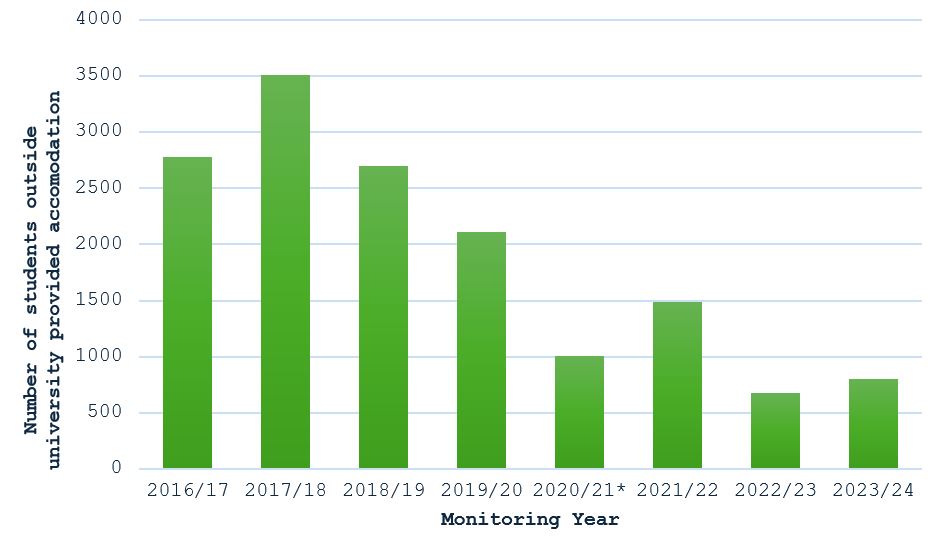
(*Note: Student numbers contributing to the threshold for 2020/21 onwards have been redefined according to the Local Plan 2036 definition and only include full-time, taught-course students. Please refer to Appendix 3.5 in the Local Plan to see the full list of student exclusions.)
| Monitoring year | Total number of students | Students needing accommodation in Oxford | Units of university provided student accommodation | Students living outside of university provided accommodation |
|---|---|---|---|---|
| 2016/17 | 23,179 | 17,753 | 14,976 | 2,777 |
| 2017/18 | 23,975 | 18,221 | 15,047 | 3,508 |
| 2018/19 | 24,289 | 18,112 | 15,409 | 2,703 |
| 2019/20 | 24,510 | 18,413 | 16,299 | 2,114 |
| 2020/21 | 25,816 | 14,724 | 13,715 | 1,009 |
| 2021/22 | 26,439 | 14,873 | 13,382 | 1,491 |
| 2022/23 | 26,497 | 14,653 | 13,975 | 678 |
| 2023/24 | 26,945 | 15,404 | 14,603 | 801 |
Oxford Brookes University
3.18. Oxford Brookes University states that there was a total of 19,586 students attending the university as of 1 December 2023.
3.19. A number of agreed exclusions apply to the data:
- Part-time students (2,412 students)
- Students on a research-based PG degree (147)
- Students on a Further Education course or foundation degree (109)
- Vocational Course students who will at times during their course be on work-placements (1348)
- Students with a term-time address outside of the city (OX1, 2, 3, 4) (1699)
- Students living within the city (OX1, 2, 3, 4) prior to entry onto a course (373)
- Students studying at franchise institutions (4331 students) (The figure for this group is significantly higher than in previous years, because as of the 2022/23 monitoring period, it now includes Global Banking School (GBS) Students. This is a partnership with Oxford Brookes University to provide a BSc in Health, Wellbeing and Social Care for students. The campuses are only based in London, Birmingham, Manchester and Leeds. Therefore, these students are considered to be studying at a franchise/ partner institution and are excluded from the calculation of students at Oxford Brookes University requiring accommodation.)
- Students studying outside Oxford (i.e., Swindon campus) (265 students)
- Placement students away from the university (325 students)
3.20. Taking into account these exclusions, there were 8,577 full-time Oxford Brookes University students with accommodation requirements. As of 1 December 2023, there were 4,857 accommodation places provided by Oxford Brookes University. This leaves a total of 3,720 students without a place in university provided accommodation living in Oxford (Figure 2). It is noted from the University provided data, the occupancy rates of the University provided accommodation was at 98% overall, which is a small increase from previous monitoring years (95% in 2022/23).
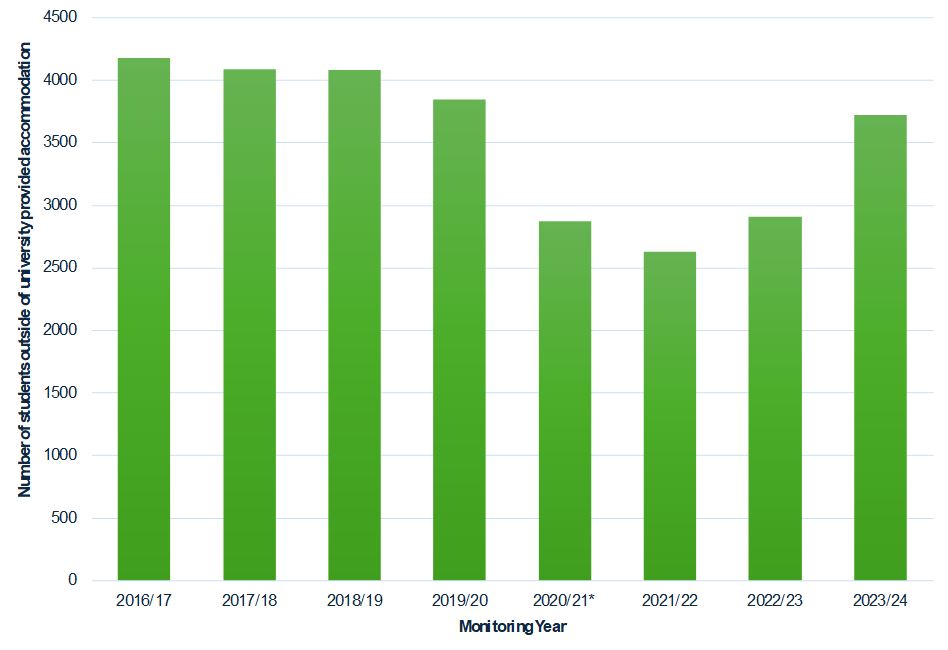
(*Note: Student numbers contributing to the threshold for 2020/21 onwards have been redefined according to the Local Plan 2036 definition and only include full-time, taught-course students. Please refer to Appendix 3.5 in the Local Plan to see the full list of student exclusions.)
3.21. When compared to the previous monitoring year, there was an increase in the number of Oxford Brookes students living outside of university provided accommodation in the city in 2023/24, although it was still well within the threshold of 4,500. A more detailed breakdown of Oxford Brookes University’s student numbers is provided in Table 8:
| Monitoring year | Total number of students | Students needing accommodation in Oxford | Units of University provided student accommodation | Students living outside of university provided accommodation |
|---|---|---|---|---|
| 2016/17 | 17,069 | 9,504 | 5,324 | 4,180 |
| 2017/18 | 16,988 | 9,494 | 5,405 | 4,089 |
| 2018/19 | 16,579 | 9,360 | 5,281 | 4,079 |
| 2019/20 | 16,673 | 9,759 | 5,914 | 3,845 |
| 2020/21 | 16,878 | 8,164 | 5,291 | 2,873 |
| 2021/22 | 16,199 | 7,794 | 5,161 | 2,633 |
| 2022/23 | 16,050 | 7,531 | 4,623 | 2,908 |
| 2023/24 | 19,586 | 8,577 | 4,857 | 3,720 |
3.22. Oxford Brookes University reports that significant progress has taken place with construction work for the Clive Booth Student Village (CBSV) site, located close to the Headington Campus, with the first phase of the development, the Elm building opening to students in January 2024. This redevelopment, when fully completed, will further increase the University’s student accommodation capacity within existing land owned by the University. The University have also reported that the number of rooms at the CBSV has also increased via a successful refurbishment programme and in addition to that they have seen an increase in the numbers of students registering an address in private student-only accommodation.
Approved additional academic and administrative floorspace
3.23. Permissions which involve the creation of additional academic and administrative floorspace, which are compliant with the requirements of policies E2 and H9 unless stated otherwise, are shown in Table 8:
| Application reference | Site location | Development summary | Net increase of academic/admin floorspace onsite (sqm) | Compliance with E2 or H9 requirements |
|---|---|---|---|---|
| 23/02125/FUL | The Flat, 118 High Street, Oxford, OX1 4BX | Change of Use of second floor from Fellows Flat (Use Class C3) to Fellows Office and Teaching Rooms (Use Class F1). | 77.6 | Yes |
Total: 77.6
Ensuring Oxford is a vibrant and enjoyable city to live in and visit
3.24. Oxford provides a wide range of services and facilities to both the city’s residents and those living in the wider catchment area, therefore it is important that the vibrancy and vitality of Oxford’s city, district and local centres are maintained and enhanced through the plan period. The vision for the Oxford Local Plan 2036 is to continue to build on these strengths and to focus growth in these centres.
3.25. Policy V1 aims to protect the vitality of the city, district and local centres within Oxford. Policies V2 – V4, meanwhile, provide the framework as to what mix of uses, such as retail or food and drink, (and identified through percentages allocated to each use class) would be acceptable within the shopping frontages of these centres, including the Oxford Covered Market. These policies place a particular emphasis on the minimum proportion of retail units at ground floor level that should be present within each shopping frontage in order to ensure that the function, vitality and viability of each centre is maintained.
Adapting to the changes to Use Classes Order
3.26. Changes to the Use Classes Order came into effect on 1 September 2020. (Current Use Classes - updated 1 September 2020 - see the Planning Portal website - Use classes). Three years have now passed, allowing adaptation to the change to occur. The changes make monitoring of policies based on the former Use Classes referred to in the Local Plan 2036 difficult.
V1 - Ensuring the vitality of centres
3.27. The Local Plan states that permission will be granted for development of town centre uses within the defined city, district, and local centre boundaries if use is appropriate to both the scale, function, and character of the area. The policy also states that the city centre will continue to be a primary location for retailing as well as other town centre uses. Continuing to provide a wide diversity of uses to shoppers will create an attractive destination for people visiting the city. One means of understanding how the centres are performing in terms of vitality is to assess how many people are using these areas throughout the year.
3.28. Figure 3 shows a footfall comparison of the 2022/23 and the 2023/24 monitoring periods. 2022/23 records the highest footfall in December and March, while the highest footfall in 2023/24 was recorded in July and August. The key and consistent trend from this comparison shows that for the majority of the year footfall is higher each month during 2023/24 than 2022/23. On average 2023/24 sees more than 100,000 more people per month than in 2023/24.
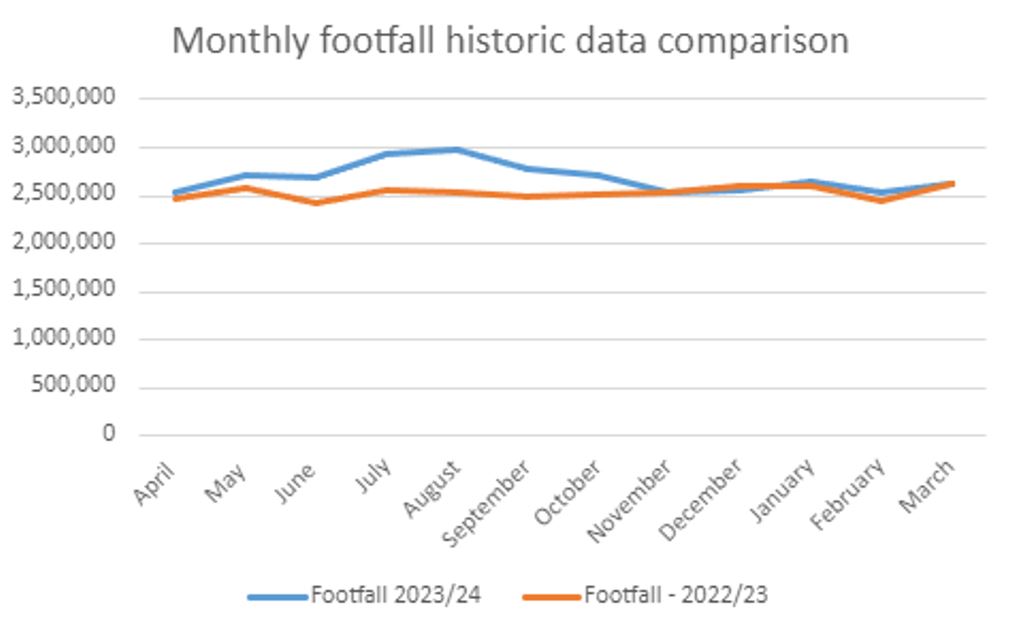
V2 - Shopping frontages in the city centre
3.29 Policy V2 sets out how shopping frontages are managed within the city centre. The policy sets out that planning permission will only be granted for proposed development that would not result in the proportion of units at ground floor level in Class A1 or other Class A uses falling below set thresholds. When applying the policy, in response to the change to the Use Class Order, the threshold required by the Policy to be Use Class A is instead applied to Use Class E. Figure 4 shows that the proportion of E Class Use in the city centre primary frontage is 94.74%, down from 97% last year. Within secondary areas of the city centre E Class uses are very similar to last year at 75.47%. This is due to the higher proportion of Sui Generis uses which remain within secondary frontage areas. Further to this, some ground floor units are now being used by university colleges for laboratory and development space. We anticipate that this will increase.
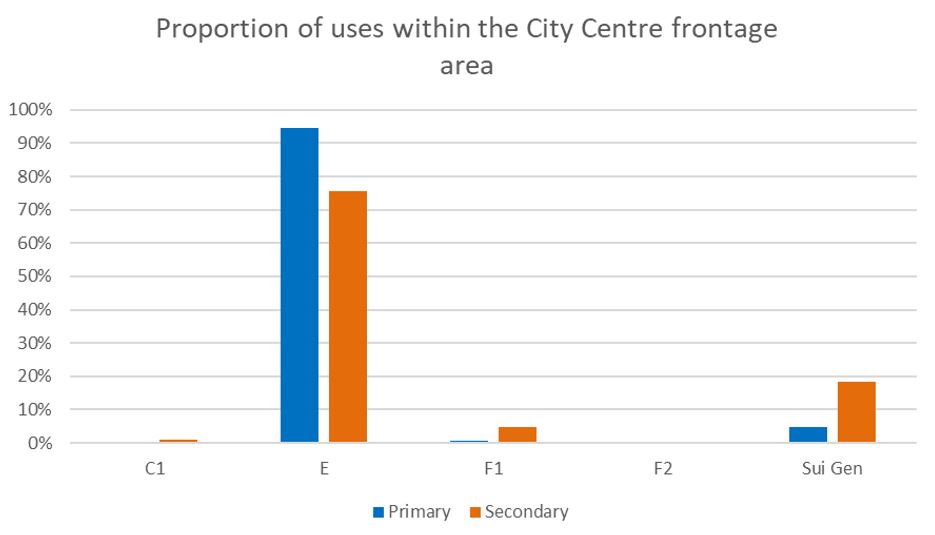
V3 - Covered Market
3.30. During the 2023/24 monitoring year there were 0 (change of use) applications permitted in the Covered Market.
V4 - District and local shopping centre frontages
3.31. Outside of the city centre area, Oxford’s district and local shopping centre frontages also play an important role in providing a wide range of services across the city.
3.32. In order to help maintain a balance of uses, Policy V4 sets out for each district centre its own individual targets in terms of A1 provision and Class A provision which is now categorised as Class E. Figure 5 shows the percentage of use class share across Oxford’s district centres. Similar to last year’s AMR, Headington, Summertown and Cowley continue to sit above the 85%. East Oxford, predominantly of the Cowley Road, remains lower in comparison to other district centres, at 80%, mainly due to a large proportion of Sui Generis uses which now includes drinking establishments and hot food takeaways within the district.
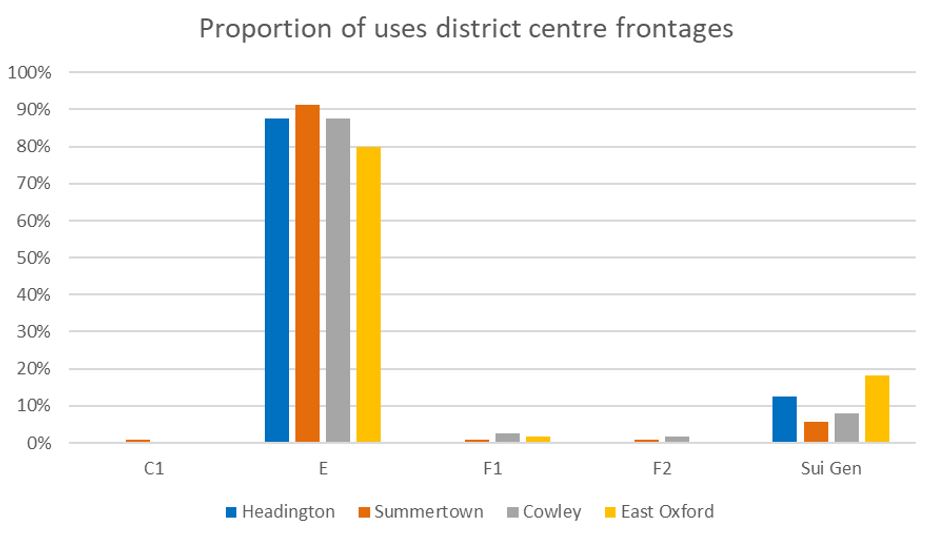
Sustainable tourism
3.33. Tourism is an important element of Oxford’s economy. The city is world famous and attracts a large number of visitors and many overnight stays; it is a crucial destination of the national tourism industry. There has been a steady increase in people back in the city post the pandemic. Over 8m people visited the city centre between September and November 2023 compared to just 7.5m in the same period of 2022.
3.34. Policy V5, ‘Sustainable Tourism’, seeks to encourage development of new tourist accommodation in the most sustainable locations which are not dependent upon the private car and that do not involve the loss of residential dwellings or affect the amenity of neighbours. Policy V5 encourages new tourist attractions in accessible locations well related to existing facilities and where such uses can contribute to regeneration.
3.35. Over the monitoring period, 3 applications were permitted involving short term accommodation, use Class C1 (Table 9). One of these permissions resulted in an increase in 36 rooms at Linton Lodge Hotel (23/00142/FUL). The other two permissions resulted in the loss of 12 short stay rooms as permission was granted for the change of use from Use Class C1 to Large Houses in Multiple Occupation (Sui Generis Use Class) (23/00295/FUL (loss of 8), and 23/00410/FUL (loss of 4)).
| Application reference | Site location | Development summary |
|---|---|---|
| 23/00142/FUL | Linton Lodge Hotel, 11-13 Linton Road, Oxford | Demolition of the rear accommodation block, conference block and pavilion building; erection of a replacement rear accommodation block, detached villa accommodation and courtyard garden accommodation; extension, alterations and reconfiguration of the hotel….. to provide 36 bedrooms, function space and operational improvements; extensive landscape enhancements, access and parking reconfiguration and associated works |
| 23/00295/FUL | 250 Iffley Road, Oxford | Change of use from hotel/bnb (Use Class C1) to a large House in Multiple Occupation (Sui Generis). Provision of cycle and refuse stores (amended description) |
| 23/00410/FUL | 58 Hollow Way, Oxford | Change of use of former guest house (Use Class C1) to a Large House in Multiple Occupation (Sui Generis) |

